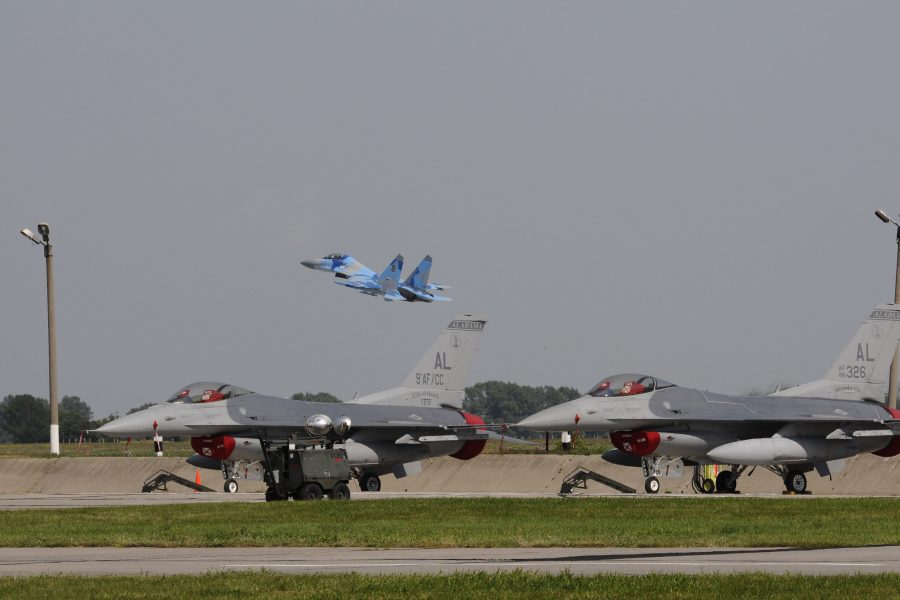While the West’s decision to train and equip Ukraine’s Air Force with American-made F-16s has garnered enormous attention, the war there is likely to remain a slugfest on the ground for months to come, U.S. military officials say.
“Just giving them an F-16 is not going to immediately turn the tide and give them air superiority,” Gen. James B. Hecker, commander of U.S. Air Forces in Europe-Air Forces Africa, told Air & Space Forces Magazine at a media roundtable at AFA’s Air, Space & Cyber Conference. “But it’s a start.”
In the meantime, Ukraine’s forces will continue to rely heavily on its artillery and mobile HIMARS launchers, which fire precision GMLRS rockets that have a range of nearly 50 miles.
President Joe Biden’s administration is also considering providing Ukraine this fall with a limited number of ATACMS surface-to-surface missiles, which have a range of 100 miles to 190 miles, depending on the model. Ukrainian President Volodymyr Zelenskyy said in a CNN interview broadcast Sept. 10 that he plans to appeal directly to President Biden for the ATACMS. The Ukrainian leader is planning to visit Washington next week to meet with Biden following his speech to the United Nations General Assembly,
Ukraine’s GMLRS rockets and JDAM Extended-Range guided bombs have already forced Russia to move high-value targets such as command and control facilities and ammunition depots farther away from the front line, and the provision of ATACMS would add to Kyiv’s striking power.
“They have enabled Ukraine to reach further back behind enemy lines and take out command and control centers,” Hecker said on Sept. 13 when asked about Ukraine’s current kit.
“The munitions, if you blow them all up, then they don’t have any. And then, if they have a small amount, then they can’t get them there,” said Hecker. “And then, if they don’t have anyone to command and control, all that kind of slows them down. That’s what has been useful.”
The U.S. has provided the GMLRS rockets with the condition they cannot be used to strike Russian territory itself, and if ATACMS are provided, they will almost certainly come with a similar stipulation in line with U.S. policy on materiel for Ukraine.
Ukraine has turned to indigenous drones for some attacks inside Russia, including air bases—though Ukraine usually does not take credit for those attacks as a matter of policy.
The F-16s Ukraine will eventually acquire will boost the country’s military, but employing the aircraft will be challenging.
Hecker, also the commander of NATO Allied Air Command, has focused on improving the alliance’s ability to counter air defenses. Hecker said defeating Russian air defenses inside occupied Ukrainian territory would be a difficult task even with Western weapons.
“It’s very difficult for 31 nations to take out their integrated air and missile defense systems, much less one country that doesn’t have the advanced systems that the other 31 in NATO have,” Hecker said.
Adding to the challenge, Russia has deployed air defenses in Belarus and on Russian territory. But Washington will almost certainly insist that they remain off limits for Ukrainian air strikes to avoid widening the conflict.
Because of Russia’s robust air defense, Hecker said the skies over Ukraine will likely remain contested for the foreseeable future and Ukraine will continue to have to employ tactics such as flying low to the ground to use terrain in an attempt to avoid radar, before popping up to launch weapons.
“I think they’re going to have to do that for a while,” Hecker said.
One area where F-16 will help is interoperability. So far, Ukraine has been employing some of its Western-provided weapons on Soviet-era aircraft, such as American HARM anti-radiation missiles and JDAM-Extended Range guided bombs as well as Anglo-French Storm Shadow/SCALP long-range cruise missiles. Those weapons have proved useful for Ukraine, but the jerry-rigged solutions can only go so far.
“We didn’t just give it to them and say, ‘Good luck,” Hecker said. “They can’t use the same tactics as us because the weapon is not as interoperable on a MiG-29 as it would be on the F-16 … they’ve done it—had some successes, had some failures.”
The inability of Ukraine and Russia to establish air superiority, Hecker said, underscores the need for the U.S. to continue the deployment of cutting-edge air and space systems.
“They haven’t been able to get air superiority on either side,” Hecker said. “Without that, what they started out doing was throwing 155 [artillery] rounds back and forth at one another. And what goes with that is mass casualties. Cities just turned into a rubble. You have collateral damage, such as schools, hospitals, and those kinds of things—some on purpose, some not. And that’s a war that I don’t think any one of us want to fight.”
